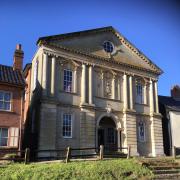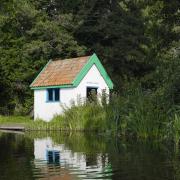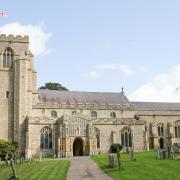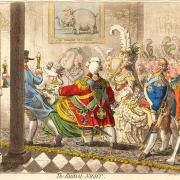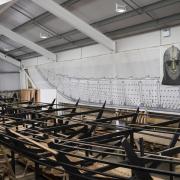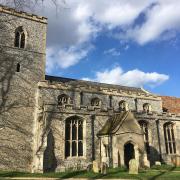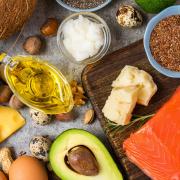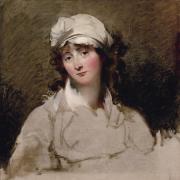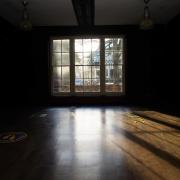The market town keeps its status as the nation’s largest silk producer rather quiet. But that’s about to change. Liz Trenow, whose family has a 300-year history in silk, reports

Why has Sudbury always been so coy about its unique claim to fame? Invite passers-by to tell you what the place is noted for and you’ll hear, variously, the market, Gainsborough, AFC Sudbury (its semi-pro football club), wool weaving and water meadows. Wikipedia dubs it ‘a small market town in the English county of Suffolk’ and the local Chamber of Commerce website an ‘ancient Chartered Market Town and birthplace of Thomas Gainsborough’.
Few seem to appreciate the truly remarkable fact that for more than 200 years the town has been a major centre of silk weaving, and is today the only place in Britain where silk is produced in any quantity. And yet hardly anyone seems to be aware of this.
Four companies between them employ several hundred highly skilled local craftspeople creating exquisite fabrics that are in demand from top end fashion and furnishing houses across the world. Representatives of internationally famous couturiers – among them Prada, Hermes, Hugo Boss, Liberty of London, Armani, Chanel – regularly beat a path to Sudbury’s door in search of special silks of exceptional quality and design to grace their next catwalk shows.
Only the tourist authority credits the town with the title it truly deserves, a title of which local people should be immensely proud and which, for the avoidance of doubt, should be emblazoned on town signs, leaflets, websites and all other tourist and marketing materials. It is Sudbury: The UK Capital of Silk.

Happily, this quiet amnesia is being addressed. Events and festivals over the next couple of years will involve local people in celebrating this unique heritage (see panel) and perhaps help to put Sudbury on the map, bringing the reputation it so sorely deserves.
Gainsborough’s House is first out of the blocks with an exhibition entitled Silk: From Spitalfields to Sudbury (open until October 8), charting the confluence of events that have brought this exotic industry to ‘a small market town in Suffolk’. Keeper Louisa Brouwer, who curated the exhibition, says: “Sudbury has been one of the most important centres for silk weaving in Britain for more than 200 years and today produces more woven silk than anywhere else in the nation, but this has largely been underappreciated. Gainsborough himself came from a weaving family so it seems very appropriate that we should stage this first ever exhibition of its kind, exploring the town’s silk heritage, past and present.” Some parts of the house itself, she added, where Gainsborough was born, and to which he returned with his family in later years, were probably used for weaving.
The exhibition opens with Gainsborough’s portrait of Harriet, Viscountess Tracy, which demonstrates why he became particularly known for his special ability to capture the nuances of textiles and costume, an appreciation he may have refined during his childhood. Had he not become an artist, he might well have become a weaver himself.
The first section of displays explores the development of the silk industry in 18th century Spitalfields, an area of London fast developing just outside the city walls at that time. England already had a thriving silk industry but the arrival of many thousands of highly skilled Protestant Huguenot weavers fleeing religious persecution from French silk centres such as Lyon and Tours brought a powerful boost to the trade for both domestic and international markets.

The glorious artistry of drawings by early 18th century designers such as Anna Maria Garthwaite, Joseph Leman and Christopher Baudouin, lent by the Victoria and Albert Museum, demonstrate why Spitalfields became famed for ‘flowered silks’, highly-decorated fabric based on floral motifs, prized for fashionable ladies’ gowns and men’s waistcoats.
The most thrilling exhibits in a section focusing on techniques are, for me at least, two Journeymen’s Pattern Books from the archive of Vanners Silk Weavers, which have rarely, if ever, been on public display. These wonderful early 19th century notebooks, originally belonging to the Spitalfields weaver Samuel Wilson, give a remarkable glimpse into the complexity of the craft.
The first has small swatches of fabric with, in tiny writing, the highly detailed specifications required for weaving them. I longed to turn the pages for more. Swatches in the second book display a range of dye techniques and colourways popular at the time such as Manganese (brown), Persian Blue, Chrome green and Pink, then considered a masculine colour!
The second half of this absorbing exhibition brings this skill and artistry to life with, as its centrepiece, a beautiful 18th century robe à la Française in brocaded silk loaned by Norwich Castle Museum and Art Gallery. From the V&A comes a pair of ladies’ laced court shoes in brocaded silk of the same period, featuring so-called ‘vandyke tongues’ as often illustrated in the work of the Flemish painter who became a fashionable English court portrait artist.

Two silk stoles, or shawls, striking in the vibrancy of their colours even after 200 years, were a key item of fashion just as they are today. These examples date from 1810, around the time the Spitalfields trade was beginning to move out of London into East Anglia.
The reasons for these moves were various. Probably the most important was the passing of the Spitalfields Acts, which sought to regularise rates of pay for journeymen weavers, but which effectively encouraged master weavers to move their trade to where wages were cheaper. Some companies had begun to mechanise processes such as ‘throwing’ (twisting) their yarns, and needed rivers or streams as a source of power, for example at Braintree and Glemsford. Transport links were improving. The railway would not arrive in Sudbury until 1849 but the roads were improving and public transport becoming more reliable.
Finally – and most often cited – there was the fact that for generations, Sudbury craftspeople had passed down their weaving skills from father to son, mother to daughter. Wool weaving was established in Suffolk in the town as far back as the 14th century, and continued right through into the 18th century when Gainsborough’s uncle and father wove, among other things, funeral shrouds. It is a sad fact that infection and disease brought many to an early death in those days, and theirs must have been a profitable business.
For all these reasons, by the mid 1800s Sudbury had become established as a major producer of silk, with more than 600 weavers recorded as working there, among them forbears of Vanners, and Stephen Walters & Sons whose first factory still stands in Acton Square (now the Dental Emporium).

The exhibition ends with samples of recently woven silks. Since the early 20th century all four Sudbury-based companies have maintained a special relationship with the royal family. Gainsborough Silk Weavers have a royal warrant for furnishing fabrics, for example, and Walters wove the wedding dresses for both Princess Anne and Princess Diana. Humphries Weaving has provided numerous silks for great houses and royal palaces. Here is an example of powder blue silk and cotton damask that currently graces the drawing room at Buckingham Palace.
The final piece in this exhibition is a brocaded dress silk produced by Stephen Walters & Sons. Even this eye-catching, complex and truly modern design, based on the British bank note and glittering with interwoven Lurex threads seems to recall the shapes and intricacies of those early Spitalfields designers. Designer Mary Katrantzou called her 2013 collection, for which it was woven, ‘small passports to an exotic otherness’. Perhaps this also describes Sudbury. A small market town, with a long and distinguished history of producing silk from yarns sourced in the exotic Far East, has a passport to fame that stretches into an ‘otherness’ far beyond Suffolk horizons, creating extraordinary fabrics that are, even today, prized all over the world.
So congratulations to Gainsborough’s House for a fascinating exhibition. It is open until October 8, Mondays to Saturdays 10am to 5pm, Sundays 11am to 5pm. Entrance includes access to the rest of Gainsborough’s House with its charming Georgian rooms housing permanent displays, and a tranquil garden.
£7 for adults, £16 for families, £2 students and children (up to 5s go free). Pre-booked parties of 10 or more pay £6 per head.
Other celebrations of Sudbury’s status as UK Capital of Silk will include:
Sudbury, Silk and the Huguenot Heritage, Monday August 28.
An afternoon of events at Gainsborough’s House, entry £10, half price for full-time students, includes admission to the house and current exhibition.
2pm Liz Trenow will talk about her research into the 300-year history of her family, silk weavers Stephen Walters & Sons, and how it has inspired her novels. 4pm weaver and textile scholar Richard Humphries of Humphries Silk Weaving Company talks about his work in his talk entitled Silk: from China to Sudbury.
To book visit www.gainsborough.org, tel 01787 372958 or email mail@gainsborough.org
A Festival of Silk, June – September 2018 will involve local people in a wide-ranging series of events to include:
• Silk worm statues decorated by local artists and schools
• Talks, films and theatrical events at the Quay Theatre
• A fashion show of ‘silk through the ages’
• Silk walks
• Silk buntings made by local quilters
• ‘Virtual reality’ tours of the mills
The festival is being co-ordinated by Town Centre Manager Ami Birrell. To get involved, please contact her on 01787 372331 email ami.birrell@sudburytowncouncil.co.uk
Liz Trenow (née Walters) was born and brought up in Sudbury and is the author of four novels, three of which were inspired by her silk heritage. She has also researched and written the 300-year history of her family’s company from their origins in Spitalfields in 1720 (as yet unpublished). More at www.liztrenow.com




